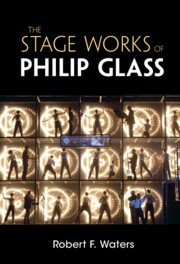Book contents
- The Stage Works of Philip Glass
- The Stage Works of Philip Glass
- Copyright page
- Dedication
- Contents
- Figures
- Tables
- Music Examples
- Selected Stage Works of Philip Glass
- Preface
- Acknowledgments
- Part I Background
- Chapter 1 Introduction
- Chapter 2 Terminology and Stages of Minimalism
- Chapter 3 Terminology: Post-Minimalism, Postmodernism, and Neo-Romanticism
- Chapter 4 Philip Glass’s Early Life and Career, 1937–1975
- Part II Stage Works
- Notes
- Select Bibliography
- Index
Chapter 2 - Terminology and Stages of Minimalism
from Part I - Background
Published online by Cambridge University Press: 21 July 2022
- The Stage Works of Philip Glass
- The Stage Works of Philip Glass
- Copyright page
- Dedication
- Contents
- Figures
- Tables
- Music Examples
- Selected Stage Works of Philip Glass
- Preface
- Acknowledgments
- Part I Background
- Chapter 1 Introduction
- Chapter 2 Terminology and Stages of Minimalism
- Chapter 3 Terminology: Post-Minimalism, Postmodernism, and Neo-Romanticism
- Chapter 4 Philip Glass’s Early Life and Career, 1937–1975
- Part II Stage Works
- Notes
- Select Bibliography
- Index
Summary
The term “minimalism” was first employed in the visual art world: painting and sculpture during the early 1960s was often abstract and inert presenting flat surfaces rather than depth or decorative detail. Minimalist artists used right angles and other clear and simple geometric forms and structures , while emphasizing stasis and impersonality. Applying the term to music is often credited to critic Michael Nyman, who allegedly borrowed the idea from art in 1968 when describing a music performance. Nyman elaborated on the label by citing works with limited or minimal music materials, whether these materials were pitches, rhythms, text, or instruments. These works avoided dissonance and release of tension as prime ingredients and eschewed contrast. Repetition was highlighted, though was often an illusion, as seeming repetition often proved to consist of changes, albeit slight, whether rhythmic or otherwise. Ironically, the term minimalism became popular at a time when Glass’s works, including his stage works, were no longer minimalist in the strict definition of the term. Discussing the developmental stages of minimalist composition is the prime goal of this chapter.
- Type
- Chapter
- Information
- The Stage Works of Philip Glass , pp. 8 - 28Publisher: Cambridge University PressPrint publication year: 2022



